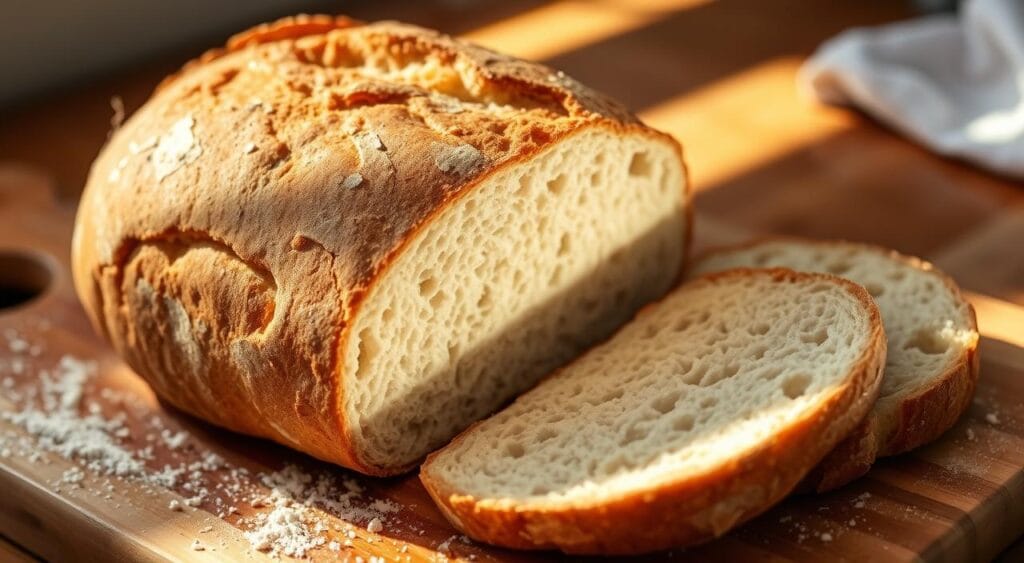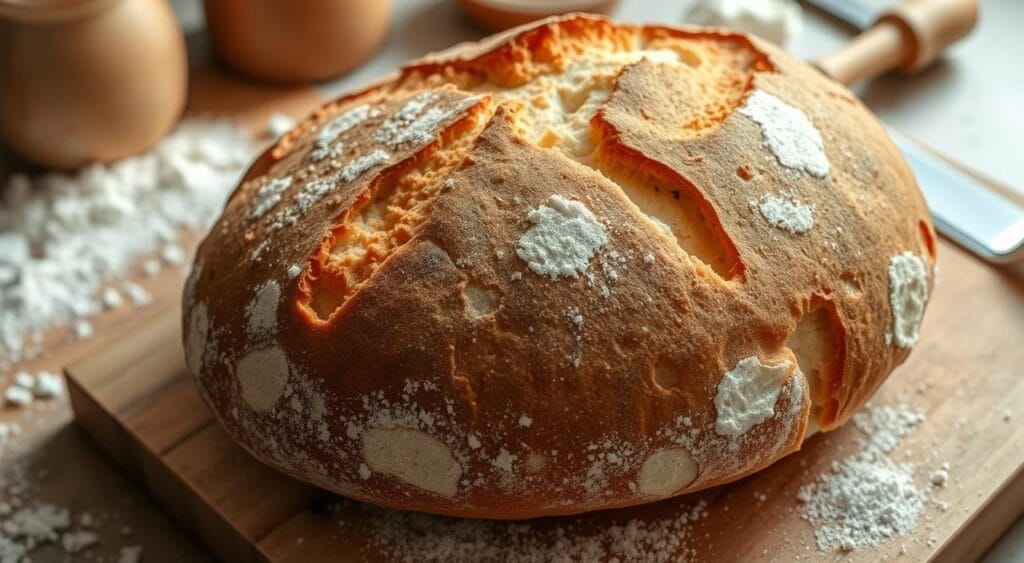Table of Contents
The smell of fresh bread in the kitchen brings back memories of my grandmother’s home. As a kid, I loved watching her knead the dough. Her joy is what I aim for in my baking today.
Homemade bread feeds the soul. Today, I’m excited to share a recipe that brings comfort and connection to your kitchen. This Sourdough Sandwich Bread Recipe is easy to make. It lets you enjoy sourdough’s tangy taste and soft texture without a starter.
Key Takeaways
- Discover a simple Sourdough Sandwich Bread Recipe that doesn’t require a traditional starter
- Learn about the science and benefits of sourdough bread making
- Understand the essential ingredients and equipment needed for perfect homemade sourdough
- Explore step-by-step instructions for creating a beautifully textured and flavorful loaf
- Uncover tips and techniques for mastering the art of sourdough baking
Understanding the Magic of Sourdough Sandwich Bread Recipe Making
Exploring the world of sourdough starters and wild yeast fermentation reveals the heart of homemade bread. Unlike commercial breads, sourdough uses a special fermentation process. This process brings out a mix of flavors and health benefits.
The Science Behind Wild Yeast Fermentation
The magic of sourdough comes from its natural leavening. It uses wild yeast and beneficial bacteria. These microorganisms turn simple flour and water into a flavorful dough. The fermentation process gives sourdough its sour taste and boosts its nutritional value.
Benefits of Homemade Sourdough
- Improved gut health: The fermentation breaks down gluten, making sourdough easier to digest.
- Increased nutrient absorption: Sourdough has more vitamins, minerals, and antioxidants than regular bread.
- Longer shelf life: The sourdough’s acidic environment stops mold and bacteria, keeping bread fresh longer.
Basic Equipment You’ll Need
To start making sourdough, you’ll need some basic tools:
- A sourdough starter, the base of your bread
- A strong mixing bowl and a dough scraper or spatula for kneading
- A loaf pan or baking sheet for baking your bread
- A digital scale for accurate ingredient measurements
- A spray bottle for a crisp, golden crust
With the right tools and practice, you’ll make delicious homemade sourdough. It will wow your family and friends.
Essential Ingredients for Perfect Sourdough Sandwich Bread Recipe
Making the perfect sourdough sandwich bread starts with the right ingredients. You need high-quality sourdough ingredients, the right amount of bread flour, and salt. Each part is crucial for the final loaf. Let’s dive into the science behind these ingredients and learn how to bake an amazing sourdough sandwich bread.
The Flour Foundation
The base of any great sourdough bread is the flour. You need bread flour that’s rich in protein and gluten. This gives the bread its chewy texture and sturdy structure. Look for flour with 12-14% protein for the best results.
With your sourdough starter, this flour makes a loaf that rises well and has a great crumb.
The Importance of Salt
Salt is key for flavor and controlling fermentation. The right amount of salt enhances the sourdough’s taste and balances yeast activity. Try different salts like sea salt or Kosher salt to find your favorite flavor.
Hydration Matters
The water in your recipe affects the bread’s texture and consistency. Aim for a dough that’s pliable but holds its shape. This balance gives you a soft crumb and a crisp crust.
| Ingredient | Purpose | Recommended Amount |
|---|---|---|
| Bread flour | Provides structure and chewiness | 500g (approximately 4 cups) |
| Salt | Enhances flavor and controls fermentation | 10g (approximately 2 teaspoons) |
| Water | Hydrates the dough for optimal texture | 350-400g (approximately 1 1/2 – 1 3/4 cups) |
| Sourdough starter | Provides natural leavening and signature flavor | 100g (approximately 1/2 cup) |
Knowing the role of each ingredient helps you make a sourdough sandwich bread that looks great and tastes amazing.
Creating and Maintaining Your Sourdough Starter
Making a sourdough starter is key to baking tasty homemade bread. Knowing how to feed it, spotting a healthy starter, and fixing common problems will keep your starter in top shape. This way, it’s always ready to help your bread rise.
Feeding Schedule for Active Starter
To keep your sourdough starter lively, follow a regular feeding plan. Feed it once or twice a day with equal parts flour and water by weight. This keeps the right mix of yeast and bacteria, making sure your starter is always ready to go.
Signs of a Healthy Starter
- Bubbly and active, with a slightly domed or rounded top
- Has a pleasant, slightly fermented aroma, without any off-putting smells
- Doubles or triples in volume within 4-8 hours of feeding
- Passes the “float test,” where a small amount of starter floats in water
Troubleshooting Common Starter Issues
If your sourdough starter seems slow or acts strangely, don’t fret. Here are some common problems and fixes to keep your starter healthy and active:
- Hooch formation (dark liquid on top): This means your starter is hungry. Get rid of some and feed it fresh flour and water.
- Sour or unpleasant aroma: Your starter might be too ripe or too acidic. Get rid of some and add more flour to balance it out.
- Lack of rise or activity: Your starter might be sleeping or weak. Try feeding it more often or add a bit of whole wheat flour to wake it up.
By following these tips for your sourdough starter, you’ll be well on your way to baking amazing homemade bread. With regular care and attention, your starter will always be ready to help your bread rise.
Discover a delicious no-butter bananabread that shows the fun of baking with natural fats and oils.
“The key to a healthy sourdough starter is patience and consistent care. With the right feeding schedule and troubleshooting techniques, you can keep your starter thriving for years to come.”
Step-by-Step banana bread recipe with two bananas
Learn to bake your own sourdough sandwich bread at home. This recipe will show you how to make a tasty loaf of sourdough bread. It’s great for sandwiches, toast, and more.
Mixing the Dough
Start by mixing your sourdough starter, warm water, and a pinch of salt in a big bowl. Stir until it’s a shaggy dough. Then, add bread flour and knead until it’s smooth and elastic.
Folding and Shaping
- Knead the dough on a floured surface for 10 minutes. It should be smooth and soft.
- Put the dough in a greased bowl, cover it, and let it rise for 8-12 hours. It should double in size.
- Punch down the dough to get rid of air bubbles. Shape it into a loaf and put it in a greased pan.
Baking the Bread
Heat your oven to 375°F (190°C). Bake the sourdough sandwich bread for 30-35 minutes. It should be golden brown and the inside should be 205°F (96°C). Let it cool on a wire rack before slicing.

This sourdough bread recipe gives you a perfect loaf. It has a crisp crust and a soft, tasty inside. Enjoy it with your favorite sandwich bread recipes or with toppings.
Mastering the Art of Dough Hydration
Getting the dough just right is key to making great sourdough bread. It’s all about dough hydration and water temperature. Mastering these will give you a bread that’s light and airy, with a golden crust.
Understanding Water Temperature Impact
The water’s temperature affects your dough a lot. Warmer water, between 80°F to 90°F, makes yeast work faster. This means your dough rises quicker. But, cooler water makes yeast work slower, letting flavors develop more.
Try different water temperatures to see what works best for your sourdough starter and recipe.
Achieving Perfect Dough Consistency
- Go for a dough hydration of 65-75%. This makes the dough soft and slightly sticky, perfect for working with.
- Watch how the dough feels as you mix and knead. It should be smooth, elastic, and a bit sticky. It shouldn’t be too wet or dry.
- Change the flour and water amounts to get the right dough consistency. More water makes the bread light and airy. Less water makes it dense.
By getting good at dough hydration and knowing about water temperature, you’ll make sourdough bread that’s a hit every time.
“The perfect dough consistency is like a well-choreographed dance – a delicate balance of hydration, temperature, and technique.”
Kneading and Folding Techniques for Optimal Structure
Getting the perfect sourdough bread starts with bread kneading and dough folding. These steps are key to making the gluten network. This network gives your bread its chewy texture and sturdy crumb.
To start, knead your dough for 10-15 minutes. Use stretch-and-fold motions. This strengthens the gluten strands and makes the dough elastic and pliable. Be gentle when kneading to avoid tearing the gluten.
- After kneading, let the dough rest for 30 minutes to an hour. This lets the gluten relax and become easier to work with.
- Then, do a series of dough folds every 30 minutes during bulk fermentation. Stretch the dough and fold it over itself, turning the bowl a quarter-turn after each fold.
- This folding helps develop the gluten further. It makes the crumb in your final loaf strong and well-structured.
| Kneading Technique | Dough Folding | Gluten Development |
|---|---|---|
| Stretch-and-fold motions for 10-15 minutes | Perform a series of folds every 30 minutes during bulk fermentation | Strengthens the gluten strands for a chewy texture and sturdy crumb |
Remember, handling the dough gently and consistently is crucial for the best structure in your sourdough sandwich bread. With practice, you’ll get better at kneading and folding. Soon, you’ll bake loaves that look and taste amazing every time.
Proofing and Fermentation Guidelines
Mastering bread proofing and fermentation is key for perfect sourdough sandwich bread. Knowing about fermentation methods and dough rise signs is crucial. It can greatly improve your baking.
Room Temperature vs. Cold Fermentation
There are two proofing methods: room temperature and cold fermentation. Room temperature proofing is quicker, taking 4-8 hours. Cold fermentation, done in the fridge, takes 12-24 hours or more. Cold fermentation often leads to deeper flavors and better texture.
Visual Cues for Perfect Proofing
- The dough should have doubled in size, with a noticeable increase in volume.
- Gently press the dough with your finger – it should spring back slowly, indicating the perfect level of fermentation.
- Look for small, evenly distributed air bubbles on the surface of the dough, a sign of a healthy rise.
By watching for these signs and adjusting your fermentation methods, you can get your sourdough to the perfect proofing stage before baking.
“Proofing is a delicate dance between time, temperature, and the living organisms that give sourdough its unique character.”
Baking Tips for Golden-Brown Crust
Getting a perfectly golden-brown crust on your homemade sourdough sandwich bread is a big win. It’s all about the right oven temperature and scoring techniques. These tips will help you achieve bread baking perfection.
First, make sure your oven is hot, around 450°F (230°C). This heat is key for a great crust. Let your oven preheat for at least 30 minutes before baking.
Then, add water or ice cubes to the oven at the start. This steam makes the crust shiny and crackly. But, too much steam can make the bottom soggy. So, find the right amount.
- Score the top of the dough with a sharp lame or razor blade to allow for even expansion during baking.
- Rotate the bread halfway through the baking time to ensure even browning.
- Use a digital thermometer to monitor the internal temperature of the bread, aiming for 205-210°F (96-99°C) for a perfectly baked loaf.
With these bread baking tips and practice, you’ll get that golden crust and impressive oven spring every time.

“The key to a perfect sourdough crust is all in the baking process. With the right techniques, you can transform your homemade loaf into a work of art.”
Storage and Shelf Life Recommendations
Storing your homemade sourdough sandwich bread right is key to keeping it fresh. After it cools down completely, use the best storage methods to preserve its taste.
Proper Cooling Methods
Let your sourdough loaf cool fully after baking. This step prevents moisture from making the crust soggy. Place the bread on a wire rack and cool it at room temperature for 1-2 hours before slicing or storing.
Freezing and Thawing Guidelines
To keep your sourdough bread fresh longer, freezing is a great choice. Slice the bread and lay the slices on a baking sheet. Freeze them, then move them to an airtight container or bag. To thaw, let it sit at room temperature or in the fridge overnight.
By following these tips, your homemade sourdough sandwich bread will stay fresh and tasty. Learning how to store and freeze bread will let you enjoy your sourdough creations for weeks.
Creative Ways to Use Sourdough Discard
As a sourdough baker, you’ve probably got a lot of discard. Instead of throwing it away, why not make something tasty? You can turn it into sourdough crackers or pancakes. These treats will make your taste buds happy.
Sourdough Crackers: A Crispy Delight
One great way to use sourdough discard is making sourdough crackers. Just mix it with a few ingredients, roll it out, and bake until crispy. These crackers are perfect for snacking or with dips.
Sourdough Pancakes: A Fluffy Breakfast Treat
Begin your day with fluffy sourdough pancakes. Add your discard to the batter for a tangy twist. Top with fruit, syrup, or your favorite toppings for a special breakfast.
- Sourdough Discard Recipes
- Sourdough Crackers
- Sourdough Pancakes
“Reducing food waste and getting the most out of your sourdough starter is a win-win. Get creative with your discard and enjoy the delicious results!”
There are endless ways to use sourdough discard. From savory to sweet, you can find many recipes. So, next time you have extra discard, don’t waste it. Get creative and make some tasty sourdough treats!
Troubleshooting Common Sourdough Problems
Baking sourdough bread can be rewarding, but it comes with challenges. Don’t worry, we’ve got you covered! We’ll tackle common sourdough issues and show you how to solve them. This way, you can bake perfect sourdough sandwich bread every time.
Fixing Dense or Gummy Bread
If your sourdough is dense or gummy, don’t worry. There are a few reasons why this might happen. It could be because the dough didn’t proof enough, or because of issues with dough hydration or kneading.
By adjusting your proofing time and paying attention to dough consistency, you can achieve the light, airy texture you want. Also, refining your kneading technique can help a lot.
Addressing Starter Issues
A healthy, active sourdough starter is key to great bread. If your starter is slow-growing or smells bad, it’s time to fix it. Check your feeding schedule and make sure you’re using the right flour.
Also, keep an eye on the starter’s temperature. Making small changes to how you care for your starter can make a big difference. This will help you bake better bread.
FAQ
What are some sourdough recipes besides bread?
You can make more than just bread with sourdough discard. Try making sourdough crackers, pancakes, or waffles. You can also use it for pizza crust or biscuits.
How do I maintain a healthy sourdough starter?
Keeping your sourdough starter healthy is key. Feed it regularly, every 12-24 hours, with flour and water. Look for signs like bubbles and it doubling in size. If problems arise, troubleshoot to fix it.
Can I use sourdough discard in recipes?
Yes, you can! Sourdough discard is great for many recipes. Use it to make crackers, pancakes, waffles, pizza crust, or biscuits. It’s a fun way to use up extra starter and reduce waste.

